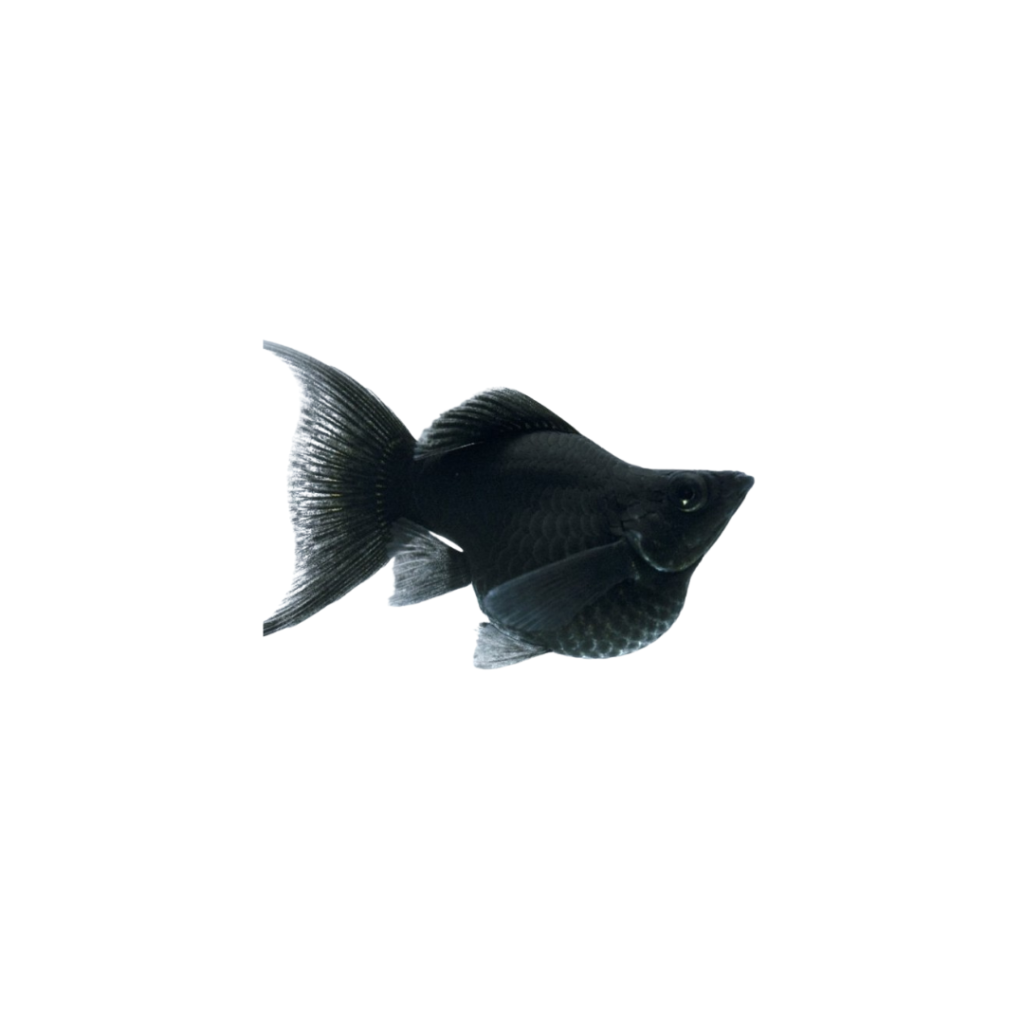Guppy Tuxedo
Poecilia reticulata

Description
The Guppy Tuxedo is a striking and elegant variety of guppy that is famous for its “tuxedo” coloration, which resembles a formal suit. These guppies typically have a deep, dark body coloration (black or dark blue), with a contrasting light or vibrant color on the tail and body. The tail fin is often brightly colored, showcasing hues of red, orange, or yellow, and sometimes features a pattern or gradient effect. The “tuxedo” look is created by the stark contrast between the dark body and the brightly colored tail, reminiscent of a tuxedo suit.
Habitat Origin
Native to the freshwater rivers, lakes, and streams of Central and South America, particularly in Mexico, Venezuela, and Trinidad. Guppies, including the Tuxedo variety, are commonly found in tropical waters with moderate to slow-moving currents. The Tuxedo guppy has been selectively bred for its unique and eye-catching coloration, with the goal of creating a guppy with a distinctive, tuxedo-like appearance.
Aquarium
Ideal Number in Aquarium: Best kept in groups of at least 4-6 individuals. The more, the better, as guppies are social and thrive in schools.
Favorite Food

Guppy Tuxedos are omnivores and will accept a variety of foods. They can be fed high-quality flake food, micro pellets, and live or frozen foods such as brine shrimp, daphnia, bloodworms, and grindal worms. They also enjoy vegetable-based foods like spirulina, blanched zucchini, lettuce, and spinach. A balanced diet is important for maintaining their health and vibrant coloration.
Behavior:
The Guppy Tuxedo is a peaceful, active species. They are typically seen swimming in the middle and upper regions of the tank. Guppies are social fish and do well in groups, where they can interact with each other and feel secure. While they are generally peaceful, males may occasionally show territorial behavior, especially during breeding periods when they compete for the attention of females.
Special Care:
Guppy Tuxedos are hardy fish that adapt well to a variety of water conditions. However, they do best in stable, clean water with a moderate hardness level. Regular water changes, good filtration, and a well-maintained tank are necessary to keep them healthy. These fish are livebearers, so they will breed in community tanks if both males and females are present. If breeding is not desired, it’s recommended to keep only males or separate the sexes.
Compatibility with Other Fish:
Guppy Tuxedos are compatible with a wide variety of peaceful species. They can be kept with other guppy varieties, tetras, rasboras, gouramis, and small catfish like Corydoras. They should not be kept with large or aggressive fish, such as bettas, cichlids, or goldfish, as these fish may bully or eat the guppies.
Breeding Tank Setup
Although not mandatory, a separate breeding tank for Guppy Tuxedo is highly recommended to minimize stress and prevent fry predation. A tank size of 20–40 liters (5–10 gallons) provides enough space for the breeding pair and their offspring. Ideal water conditions include a pH of 7.0–8.0, temperature between 24–28°C, and a general hardness of 6–12 dGH. Use a sponge filter or low-flow internal filter to ensure gentle water circulation and clean conditions without harming the fry. A fine gravel or sand substrate paired with live plants like Java moss and floating vegetation creates an ideal environment that offers both shelter and spawning areas.
Conditioning for Breeding
To prepare Guppy Tuxedo for breeding, feed them a protein-rich and varied diet. Include live or frozen foods such as brine shrimp, daphnia, and bloodworms alongside premium guppy flakes or pellets. This conditioning improves fertility and triggers mating behavior. Regular partial water changes of 20–30% weekly help maintain water quality, and a slight increase in temperature to 28°C can further encourage spawning readiness.
Spawning Process
Spawning generally begins once the fish are healthy and the environment is stable. The male actively courts the female by displaying his vibrant tail and chasing her around the tank. Guppies are livebearers, so internal fertilization occurs, and the female gives birth to fully developed fry after 4–6 weeks of gestation. Depending on her size and health, a female Guppy Tuxedo may produce 20 to 100 fry per batch. While separating the female after birthing is not required, doing so can protect the newborn fry from being eaten.
Fry Care & Feeding
Guppy Tuxedo fry are free-swimming at birth and should be fed with infusoria or liquid fry food in the first few days. As they grow, you can introduce finely crushed flakes or newly hatched brine shrimp. To support healthy development, maintain water cleanliness with 10–15% water changes every 2–3 days, and ensure stable temperatures between 24–28°C. A sponge filter is recommended for safe filtration, and plenty of plant cover or hiding spots will help reduce stress and increase fry survival rates.
Breeding Age, Sexing & Stress Reduction
Guppy Tuxedo typically reaches sexual maturity around 3–4 months of age. Males are smaller and more colorful, with a gonopodium (modified anal fin) for fertilization, while females are larger, rounder (especially when gravid), and less vivid. To prevent stress, avoid overcrowding and maintain stable water parameters. Remove aggressive or hyperactive tankmates, and provide shaded zones and quiet corners to keep both breeders and fry calm and healthy.
